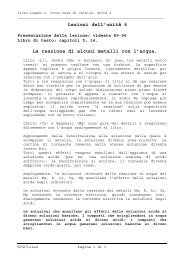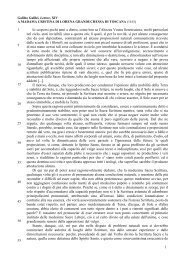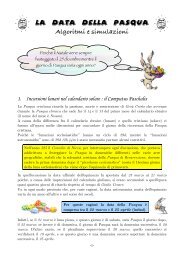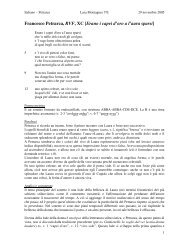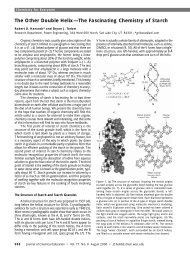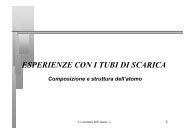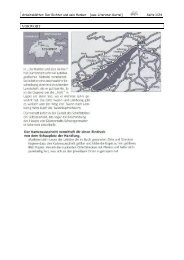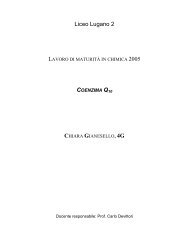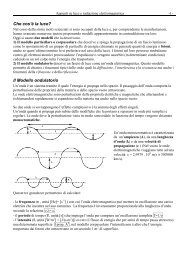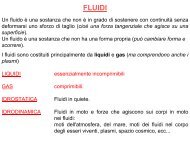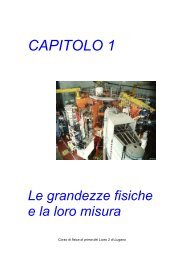Supercritical impregnation of polymers - ZyXEL NSA210
Supercritical impregnation of polymers - ZyXEL NSA210
Supercritical impregnation of polymers - ZyXEL NSA210
You also want an ePaper? Increase the reach of your titles
YUMPU automatically turns print PDFs into web optimized ePapers that Google loves.
I. Kikic, F. Vecchione / Current Opinion in Solid State and Materials Science 7 (2003) 399–405 403<br />
in the case <strong>of</strong> Fe(III)–HFDI it arrives at 57.6% while the<br />
content <strong>of</strong> iron is 1.5–4.5%. It was shown that after<br />
thermal heating the copper atom is in a nearly univalent<br />
state. The size <strong>of</strong> metal-containing particles ranges from<br />
15 to 60 nm (with a maximum at 34 nm), which corresponds,<br />
for example, to the size range <strong>of</strong> catalytic particles<br />
used in heterogeneous catalysis (2–50 nm) [16].<br />
3.4. Monomer and initiator <strong>impregnation</strong> (polymer<br />
blends)<br />
One <strong>of</strong> the most interesting applications <strong>of</strong> supercritical<br />
fluid <strong>impregnation</strong> is the modification <strong>of</strong> <strong>polymers</strong><br />
via the infusion <strong>of</strong> a monomer and an initiator into<br />
aCO 2 -swollen polymer matrix with subsequent polymerization<br />
<strong>of</strong> a monomer within the polymer matrix for<br />
the preparation <strong>of</strong> polymer blends [19].<br />
With SCCO 2 it is possible to obtain polymer modifications<br />
by avoiding thermal stresses.<br />
The <strong>impregnation</strong> <strong>of</strong> styrene and acrylic acid into a<br />
series <strong>of</strong> polyamide products (nylon1212, nylon1010,<br />
nylon66, nylon6) using supercritical CO 2 as additive<br />
carrier and substrate-swelling agent was performed by<br />
Xu and Chang [20].<br />
The <strong>impregnation</strong> efficiency <strong>of</strong> additives into substrates<br />
is attributed to complicated interactions within<br />
the systems.<br />
In the examined pressure range from 8 to 16 MPa,<br />
acrylic acid always has a higher <strong>impregnation</strong> uptake<br />
than styrene.<br />
It was found that the relative solubility <strong>of</strong> the additive<br />
in the polymer substrate and CO 2 is a major factor<br />
governing the incorporated amount; however swelling <strong>of</strong><br />
the substrate and CO 2 -induced crystallization also contribute<br />
to the value [20].<br />
Li et al. [21] studied the preparation <strong>of</strong> nanometer<br />
dispersed polypropylene/polystyrene (PP/PS) interpenetrating<br />
networks (IPNs) by the radical polymerization<br />
and crosslinking <strong>of</strong> styrene (St) within supercritical CO 2 -<br />
swollen PP substrates. In this method, monomer styrene<br />
(St), crosslinking agent divinyl benzene (DVB), and the<br />
initiator benzoyl peroxide (BPO) were first impregnated<br />
into PP matrix using SCCO 2 as a solvent and swelling<br />
agent at 35.0 °C, and then the polymerization and<br />
crosslinking were carried out at 120 °C.<br />
The PP/PS IPNs mass uptake increases initially with<br />
soaking time, and it is independent <strong>of</strong> soaking time after<br />
about 13 h when equilibrium conditions are reached.<br />
A maximum <strong>of</strong> PP/PS IPNs mass uptake is shown at<br />
about 140 bar. This is due to the competition between<br />
two opposite effects with increasing pressure: the degree<br />
<strong>of</strong> swelling <strong>of</strong> the polymeric matrix and the solubility <strong>of</strong><br />
the monomers in the CO 2 -rich phase.<br />
The composition <strong>of</strong> the IPNs can be controlled by<br />
SCCO 2 pressure and concentrations <strong>of</strong> St and DVB in<br />
the fluid phase.<br />
The synthesis <strong>of</strong> conducting <strong>polymers</strong> has become an<br />
important research area since its discovery in the past 20<br />
years. Most conducting <strong>polymers</strong>, such as polypyrrole<br />
(PPy), poly(3-octyl thiophene), polyaniline, were synthesized<br />
by oxidative or electro-chemical polymerization [21].<br />
One way to overcome the poor mechanical properties<br />
<strong>of</strong> these conductive <strong>polymers</strong> is to blend them with another<br />
insulating polymer.<br />
Tang et al. [22,23] investigated the preparation <strong>of</strong><br />
electrically conductive polypyrrole–polystyrene composites<br />
by supercritical carbon dioxide <strong>impregnation</strong>.<br />
These authors studied:<br />
1. The effect <strong>of</strong> the blending conditions;<br />
2. The effect <strong>of</strong> doping conditions.<br />
The host polymer was blended with pyrrole monomer<br />
using either supercritical carbon dioxide or high-pressure<br />
liquid carbon dioxide (HPLCO 2 ) near the supercritical<br />
conditions as the carrying solvent. After the<br />
blending process, the blended host polymer was soaked<br />
in an oxidant metallic salt solution.<br />
For blending the host polymer with pyrrole monomer,<br />
SCCO 2 provides better conditions than HPLCO 2<br />
at the same density. The maximum conductivity <strong>of</strong> the<br />
polymer composites also increases with temperature and<br />
pressure at the same SCCO 2 density and it is about one<br />
order <strong>of</strong> magnitude higher in SCCO 2 than in HPLCO 2 .<br />
This result can be explained by the swelling efficiency in<br />
the blending period, which is a controlling factor for the<br />
structure and conductivity <strong>of</strong> the resulting composites.<br />
Referring to the doping conditions, acetonitrile and<br />
water were used as the doping solvents and iron<br />
perchlorate, and iron nitrate were selected as oxidants at<br />
temperatures between 15 and 45 °C.<br />
The maximum conductivity <strong>of</strong> the composites with<br />
iron compounds as oxidants decreases in the following<br />
order <strong>of</strong> anions: chloride > sulfate > perchloride > nitrate<br />
in aqueous solutions [22,23].<br />
The modification <strong>of</strong> the polymeric substrates bisphenol<br />
A poly(carbonate) (PC), poly(vinyl chloride)<br />
(PVC) and poly(tetrafluoro ethylene) (PTFE) by the<br />
vinylic monomers styrene (S), methyl methacrylate<br />
(MMA) and methacrylic acid (MAA) under supercritical<br />
conditions was performed by Muth et al. [24].<br />
The monomers solubility in SCCO 2 and their phase<br />
behaviour have been investigated in order to achieve<br />
<strong>impregnation</strong> in homogeneous phase and to prevent the<br />
extraction <strong>of</strong> the impregnated monomers during the<br />
polymerization.<br />
At 40 °C pressure conditions must be higher than 11<br />
MPa, while at 80 °C pressures below 11 MPa must be<br />
chosen.<br />
In a first step, the <strong>polymers</strong> were impregnated with<br />
the monomers and a radical initiator (azoisobutyrodinitrile<br />
(AIBN) for all cases), followed by a polymerization



